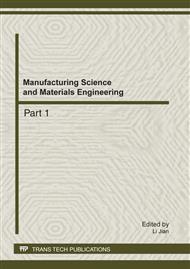p.655
p.660
p.666
p.671
p.678
p.684
p.688
p.694
p.700
Strength of Screw Thread in Vibration Tapping
Abstract:
Screw thread connection is a common way of detachable connection. The invalidation of screw thread connection will lead to mechanical failure or even retirement. Vibration tapping is essentially a kind of high-energy impact cutting which increases the rigidity of the tool. Composite vibration tapping simultaneously with repeated cutting action reduces the surface recovery of plastic materials and enhances metal cutting rate. Theoretical study and experimental results show that vibration tapping improves the metal cutting rates, enhances the machining accuracy and makes screw thread connection assembly easier. At the same time, vibration tapping process does not reduce the strength of screw thread. As the screw thread can be more uniformed cut at different depths, vibration tapping enhances the strength of screw thread slightly.
Info:
Periodical:
Pages:
678-683
Citation:
Online since:
January 2012
Authors:
Keywords:
Price:
Сopyright:
© 2012 Trans Tech Publications Ltd. All Rights Reserved
Share:
Citation:


